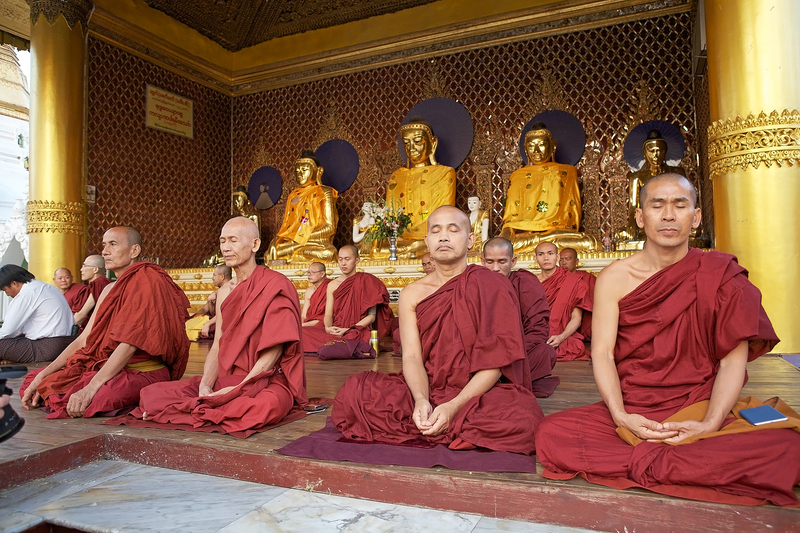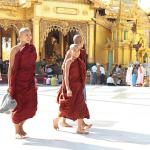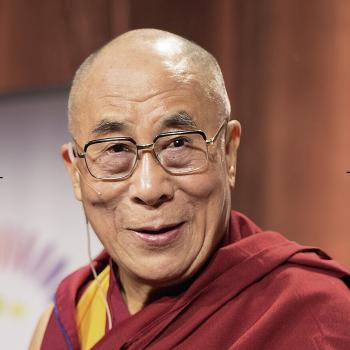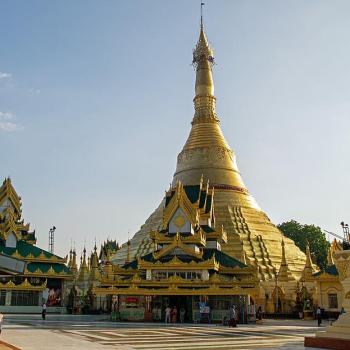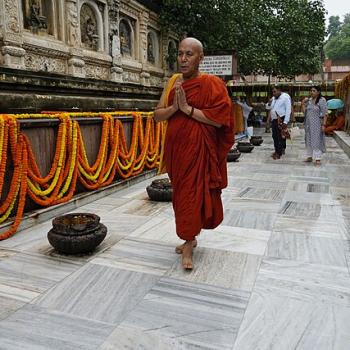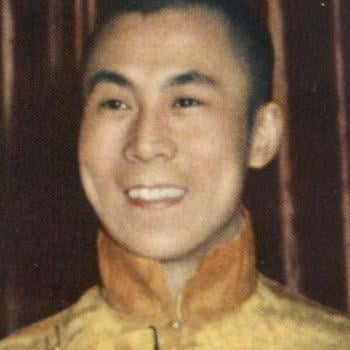This is the story of the Vipassana Movement, which began in 19th century Burma — today’s Myanmar — and spread around the globe. And the story begins with an invasion. In 1885 British troops entered Mandalay, Burma, and deposed the King. For the Burmese this created a religious as well as a political crisis. The King was the head and protector of Buddhism in Burma. As the last King of Burma, Thibaw, was taken away to exile in an oxcart. the Burmese wondered if Burmese Buddhism would survive. Buddhist institutions, the many monasteries, had long relied on the patronage and leadership of their monarchs.
The British colonial government did not assume those duties. After 1885 Burma was part of the British Raj as a province of India. Queen Victoria’s policy was to leave the religions of her subjects alone, which was well intentioned. But the Burmese considered this lack of support for Buddhism as an attack upon it. And the many Christian missionaries who flocked to the new British colony underscored that point. But the crisis became an opportunity. To survive, Buddhism in Burma had to change. And what emerged was remarkable.
Vipassana means “insight” in Pali, and it is the name given to a form of meditation that has ancient roots but which was revived in the 19th and 20th centuries. The invasion of Burma in 1885 set events in motion that spread the practice of Vipassana around the world.
The Vipassana Movement: Buddhism in Burma
In ancient times the territory that is now Myanmar was filled with small kingdoms and several ethnic groups. It’s believed Buddhism was practiced by at least some people in these kingdoms for many centuries, possibly going back more than two thousand years. But the verifiable history of Buddhism in Burma began with King Anawrahta (1014-1077), considered the father of the nation of Burma. The King’s importance to our story is that he established Theravada Buddhism as the state relligion. In doing so he assumed, for himself and his descendants, the responsibilities of a cakkavattin, a “wheel-turning monarch,” which is a semi-divine figure. A scripture from the Pali Canon called the Cakkavatti Sutta describes the noble and sacred duties of such a monarch to uphold Buddhism for his people. To the people of Burma, the king’s government existed solely to protect and support Buddhism. And Buddhism permeated all aspects of Burmese life.
Theravada Buddhism is the dominant form of Buddhism in Myanmar, Sri Lanka, Thailand, Laos, and Cambodia. Theravada means “school of the elders,” and it is widely considered to be the oldest school of Buddhism being practiced today. Whether it can legitimately claim to be the direct descendant of the original Buddhism is contested by historians, however. Theravada has long been primarily a monastic school. Only monks and nuns, it is believed, might realize enlightenment and enter Nirvana. (Note that the Theravada nuns’ orders died out centuries ago, and there are impediments to reviving them, but an effort to do so is ongoing.) For this reason, for a long time advanced teachings were reserved for monks. Likewise, instruction in meditation also was reserved for monks.
According to many scholars, however, for a few centuries Theravada monks did little meditation. Theravada monks and laypeople alike primarily focused on moral behavior, and the monks also studied and preserved their body of scriptures, the Pali Canon. In the 18th century a Burmese monk named Medawi (1728-1816) rekindled interest in meditation and wrote manuals of instruction for meditators. Still, meditation wasn’t that common. But then in the 19th century the British troops came, and the King was deposed.
The Response
With the wheel-turning king gone, the people of Burma took on the task of supporting Buddhism. Laypeople of Burma organized and pooled resources to feed and clothe whole monasteries. Many also began to study the Buddha’s teachings more deeply, both to preserve them and to respond to the Christian missionaries who insisted Christianity was superior.
In 1886, the year after the king was deposed, a Burmese monk who had taken the name Nana-dhaja (the banner of knowledge) went into retreat in Ledi forest, to the north of Monywa. He did not remain alone for long. Many other monks sought him out and asked the Venerable Nana-dhaja to teach them. A new monastery was built, and the venerable monk took the name by which he is best known, Ledi Sayadaw (“venerable monk from Ledi”; 1846-1943). Ledi Sayadaw understood that the best way to preserve the Buddha’s teachings was to put it in as many hands as possible. He wrote manuals about the Buddha’s teachings in Pali and Burmese languages and taught meditation to anyone who wished to learn.
Other monks of Burma followed Ledi Sayadaw’s example, and by the early 20th century a new way of being Buddhist had emerged in Burma. Monks took the revolution beyond the borders of Burma, to other Theravadin countries. In Thailand a new Buddhist monastic order, the Thai Forest Tradition, emerged in about 1900. This order emphasizes living as the original Buddhist monks lived, and this also included placing greater emphasis on meditation. A major revival of Buddhism in Ceylon, today’s Sri Lanka, had also begun in the late 19th century. Anagarika Dharmapala of Sri Lanka emerged as a major leader of Buddhism in Asia and the West. Dharmapala made quite a splash at the 1893 World Paliament of Religions in Chicago. In 1926, Dharmapala established the first Theravada Bubbhist monastery outside Asia, the London Buddhist Vihara.
Vipassana Meditation Around the World
So it was that the revival movement in Theravada Buddhism intersected with a new interest in Buddhism in the West. One of the first westerners to study and train in Burma was U Dhammaloka (1856-1914), The venerable Dhammaloka originally was Laurence Carroll of County Dublin, Ireland, who was ordained in Burma some time before 1900. There also was Ananda Metteyya (1872-1923), originally the London-born Charles Henry Allan Bennett, who also was ordained in Burma. And there was Nyanatiloka Mahathera (1878-1957), originally Anton Walther Florus Gueth of Wiesbaden, Germany, who was inspired by Ananda Metteyya to become a monk in Burma.
Now we fast-forward to the 1960s, when many westerners were making the journey to the east to explore Buddhist monasticism. Among these was the American Jack Kornfield, b. 1945, whose principal teacher was the Thai Forest master Ajahn Shah. In 1975 Kornfield co-founded, with Sharon Salzberg and Jack Goldstein, the Insight Meditation Society of Barre, Massachusetts. The IMS now is at the hub of a network of insight meditation centers around the globe.
Another important figure in the Vipassama Movement was Satya Narayana Goenka, better known as S.N. Goenka, 1924-2013. Goenka was from an Indian business family living in Burma/Myanmar, where S.N. was born. He trained under the master Vipassana teacher Sayagyi U Ba Khin, who also was the first Accountain General of the indepenent nation of Burma. U Ba Khin gave Goenka the authority to teach in 1968, and Goenka dedicated the rest of his life to Vipassana. He developed a ten-day meditation retreat program to help people get started. The retreats, held at about 380 locations in 94 countries, are funded by donations. People pay only what they can, or take the course for free. Hundreds of thousands of people have gone on the retreats. When he died in 2013, Goenka was eulogized as “the man who taught the world to meditate.”
Postscripts
Vipassana or Insight Meditation is a mindfulness practice that leads to a clear awareness of the nature of reality itself. It is best learned from a master teacher, but there are books and videos available if you aren’t able to get to a teacher.
Buddhism in Myanmar has not had smooth sailing in the years since the revival. Buddhist monks were involved in anti-Muslim violence beginning in 2012, which will probably be the topic of a future post here. The violent monks were a minority acting without institutional approval, but they did have the approval of the Myanmar government. It was, and is, a terriblly complicated and messy situation.
